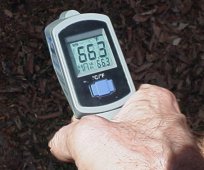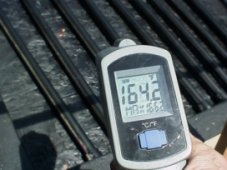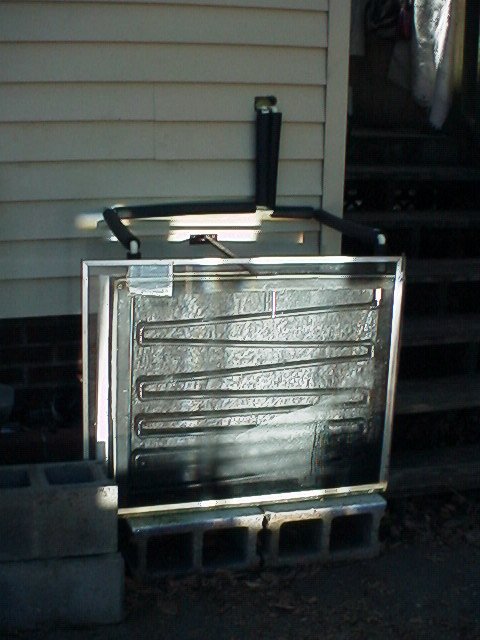|
|
Solar Powered Preheater Project |
|
|
April 12, 2009
I wanted to preheat water with solar energy before it went to my electric tankless water heater. The higher the temperature of the water going into the heater, the less electricity will be used to bring the water up to the preset temperature on the heater = money saved and it's good for the environment!
First I re-installed my old gas-fired tank-type water heater. It is not even hooked to the gas line, it will just be a holding tank for the preheated water. I plumbed it so that the supply water comes into it first and then goes to the tankless heater. I'll get some more use out of it and it won't have to go see Mr. Recycler yet.
I installed a new pressure relief valve on it for safety. I popped off the plastic drain valve at the bottom of the tank and installed a steel nipple which then adapts to cpvc. That will be the cold water feed to the solar collector. Then I installed a "T" in the copper pipe between the output of the holding tank and input of the tankless heater. That is the warm water return from the collector.
Then, I threw together a "hot box" out of 2"x4"s and a piece of particle board. I made it to the dimensions of an aluminum framed window pane I had. I just used 3" drywall screws to hold the 2"x4"s together and 1-1/4" drywall screws to put the back on. I used a lot of silicon caulk to make it as air and water tight as possible. Painted it flat black and plumbed it with 1/2" cpvc. Then I painted the cpvc black too.
|
I don't know why I used this zig-zag configuration. I just started building and this was what I ended up with. I sometimes do things like that.
It didn't occur to me until later that most of the solar collection boxes I see use a manifold across the bottom with several vertical tubes going up to another manifold at the top. Probably more efficient. But I'm sure this box will not be the one I keep. It was just a proof-of-concept quick-and-dirty.
Quick and dirty or not, it does a fine job of capturing the heat. I lifted the glass and took a reading and was surprised to find a 100 degree temperature rise!
|
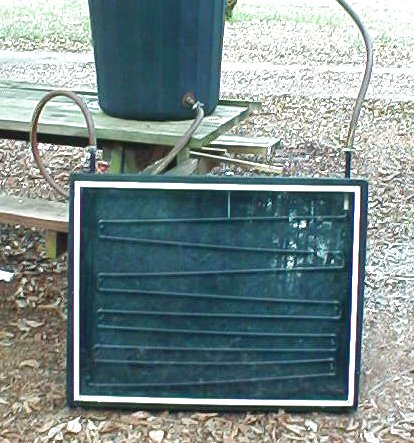
Note: This test is not a sealed system. It is open to atmospheric pressure. If you build something like this, DON'T have the return hose go higher than the level of the water in the can. Instead plumb it into the side of the can BELOW the waterline. In a sealed system, this is not a concern. |
|
So I plumbed it up to a (clean, new) plastic garbage can full of water and thermal convection started moving the water through the pipes.
(Just like hot air rises above cooler air, hot water will also rise above cooler water because the hot water is less dense thus its specific gravity is less. This is called thermal convection and we can use it to eliminate the need for a pump to circulate the water.)
The water in the garbage can will quickly stratify with the warmer water at the top and the coldest water at the bottom. The heated water in the pipes will rise, going through the hose to the top of the can. The coldest water at the bottom of the can is heavier and will be drawn into the pipes to replace the rising heated water.
And the convection was stronger than I expected with only 1/2" tubing. Bits of pollen in the water that drifted in front of the return pipe suddenly shot to the other side of the can at surprising speed.
I drilled a hole and inserted a probe thermometer so I could see the interior air temperature at any time. |
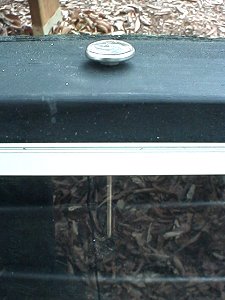 |
|
WHERE TO PUT IT?
The best place to harvest sunlight on my property would be in the middle of the front yard. Nope... eyesore! The city Yard Nazi would have a stroke when he saw it. So I decided to build a small outbuilding on the edge of the driveway and mount the solar collection box on the "roof". But... if the collector was located on the roof... then thermal convection would not circulate the water. I'd have to use a pump and I didn't want that.
While making observations with the collector hooked up to the garbage can, it got later in the afternoon and a pesky tree shaded my project. I went in the house and grabbed a largish mirror off the wall and brought it out and reflected the sun onto the collector. Hey... it worked pretty good! So I grabbed another narrower mirror I had and watched the temperature rise higher.
That's when I decided where to mount the collector. Right on the corner of the house where the holding tank was inside, only about 3 feet away! Sure, that spot is in the shade for half the day... but I've got mirrors!
 |
At first I just propped the mirrors against a concrete block. It was a pain to adjust the mirrors as the sun moved. They were top heavy and the edge resting on the ground was constantly on the verge of slipping. I eyed an old shipping crate that was scheduled to be converted into kindling and chopped it up it to make two holders for the mirrors. I did say "quick and dirty" didn't I?
The narrow mirror is still held up by a block, but I reassigned a Lazy Susan to hold the bigger mirror up.
|
Temporary but utilitarian
The crate is held to the Lazy Susan with a regular door hinge. The mirror is held up by a piece of 1/2" cpvc that pivots on a single drywall screw. There is a cpvc straight adapter with a washer inside so the long bolt will pivot inside when it is turned. The bolt is threaded through a large nut welded onto a steel plate which is held by the wooden blocks. Thus turning the bolt adjusts the verticle tilt of the mirror and the Lazy Susan handles the horizontal pan.
This, of course, will be improved upon, using motors and control electronics, but right now I just want to see the thing move hot water to my holding tank! |
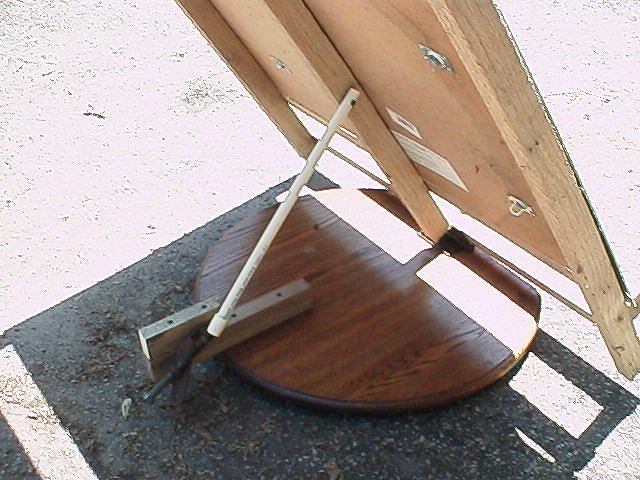 |
|
Here is the collector mounted and plumbed to my holding tank which is just inside the wall, right beside where the pipes go in. Both mirrors are reflecting on the collector and the probe thermometer went as high as 170 degrees F even though the box itself is in the shade of the house!
Kinda close to the 180 degree rating of the cpvc though! Of course, 180 degree air temperature in the box does not mean the pipe is that hot. The water is sucking the heat out of the pipe. If I get the pipe itself up to 180 degrees, then I'm doing something awfully right!
The original glass pane had an unfortunate accident and got replaced by another pane that was not quite the same size. The lady at the local recycling center is on the lookout for more glass panes and mirrors for me.
A one inch thick piece of styrofoam has been glued to the rear of the box to help insulate. Double-paned glass would no doubt be an improvement too.
It is a pleasure to put my hand on the feed pipe and then on the return pipe and feel the temperature difference. From initial tests, the water appears to get a temperature rise of 20 degrees F on each trip through.
I realize that copper would transfer the heat better than cpvc. But copper is expensive and this is just a test box. If the cpvc holds up to the heat of 3 large mirrors, I may stay with it. Otherwise, I will probably go to copper with a future collector.
I may even experiment with other forms of collectors. |
Now go build one. It's not going to build itself! You can preheat water for any type of water heating system, gas or electric, tankless or with a tank, and it will translate into savings for you. Just be safe and get professional help if you have to in order to follow local codes and so forth. Yes, that was a disclaimer.
Remember, even if what you build is not enough to supply all your needs, that doesn't matter. If it just supplements what you have, then every bit of energy you harvest is money saved! It amounts to turning sunlight into money!
Oh, one other thing --- If the ambient outdoor temperature is higher than the temperature of the water coming out of your supply pipe, this thing will work even without sunlight. That's right... on a cloudy day or even at night! If your water comes out of the supply pipe at 55 degrees and it is a cloudy, but warm 80 degree day (or night), the water will still circulate until the holding tank is at 80 degrees. And feeding 80 degree water to your heater is better than feeding it 55 degree water!
Money saved... day AND night!
Q- |
"What if it gets cold at night? Won't that cool off the water in my holding tank?" |
A- |
No. If the water in the collector is cooler than the water in your holding tank, then the cooler water will just sit there because it is heavier. Circulation will stop until the sun comes up and heats the water above the holding tank temperature. Perfect automatic control! |
Just remember that hot water rises. If your regular heater has a tank, then it needs to be at the highest point in the system. The solar collector needs to be at the lowest point and the holding tank between the two.
If you use a tankless heater, then you only have to have the collector lower than the holding tank and don't have to worry about the height of the tankless. It could even be in your basement. Don't forget to insulate all your connecting pipes.
Now what?
Well
I need automatic control of the mirrors.
I'm learning about heliostats. Heliostats are different from solar trackers. A solar tracker keeps something (like a pv panel) pointed at the sun. But I don't want to point a mirror at the sun.
A heliostat follows the sun and positions a mirror in such a way that it keeps the sun's reflection on one spot... your collection box. It is a bit more complicated than a solar tracking system because the mirror has to be pointed at an angle that exactly bisects the angle between the sun and the collection box and that angle is always changing. Also, PV panels are forgiving about the vertical tilt angle but a heliostat has to be accurate in the Z axis as well as the X and Y in order to keep the reflection on one point.
I don't want a M$ Windows controlled system. I don't really want to have to learn to use a Pic controller if I don't have too. I want it to be powered by a small lead acid battery charged with a small pv panel.
I'm leaning towards a system that uses GaP (green) LED's as sensors which control a Full Bridge Motor Driver. But I'm still in the initial stages of that. One thing I have learned is that thinking about heliostats makes my brain hurt.
For those not familiar, LED's can convert light into electricity, similar to a photovoltaic cell. Gallium Phosphate (green) LED's do it best. Three green LED's wired in series and exposed to bright sunlight will produce a voltage high enough to switch TTL logic circuitry. Before you get any ideas, LED's are not a practical replacement for photovoltaic panels. They will produce a voltage but practically no current.
I just ordered a bag of 100 water clear green LED's and spent last night destroying/salvaging two defunct printers for motors, gears, etc.
Here are links to a few Youtube videos by "helpmonkey" showing a way to track the sun with sensing LED's:
https://www.youtube.com/watch?v=-itp51tNLw8
https://www.youtube.com/watch?v=O1FBU_GCDk4
https://www.youtube.com/watch?v=97ZXlkiaYeE
Helpmonkey has a nice project website at http://www.greenwatts.info
His "Canuckle solar tracker" does a great job of keeping a photovoltaic panel pointing ~at~ the sun, but I don't want to point a mirror at the sun. The angle of the mirror needs to keep the reflection of the sun on one spot. We haven't quite figured out how to do that yet but some ideas are in the works.
Stay tuned.
I have also turned this page into an "Instructable" <-- Clicky ...and you are welcome to ask questions or make comments there.
HOME
Page updated: May 04, 2009
Free counters provided by Andale.

